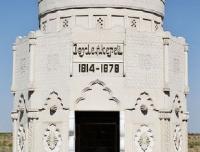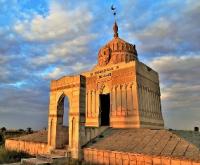You are here
Complex of Khan’s bet “Bokey Ordasy”.



Tours in historical and museum complex Bukeev horde.
“I already mentioned how Zhangir Khan became a prisoner of Baatur. We know that, having gained freedom, he annoyed the Kalmyks with constant attacks and in the end Baatur, the leader of the Dzungars, opposed him with 50,000 people, also bringing two tribes with him Alat of the Kirghiz and Tokmani (i.e. people from Alatau and Tokmak). Zhangir had only 600 people with him, but he arranged them very skillfully, dug trenches, and when the Kalmyks attacked him, he attacked them from the rear, and his a firearm caused such a panic that they lost 10,000 people! Jangir soon joined another Tatar prince by the name of Yalan¬tush with 20,000 people, and Baatur considered it prudent to retreat.In 1644, Baatur gathered his people again and resumed the fight against the Kazakhs, but the Khoshot Kundelung Taishi, who was a friend of Zhangir "intervened, and the war was postponed. This was the last mention I could find about Zhangir, who, according to Levshin, lived, like his ancestors, in Turkestan."
H.H. Howorth "History of Mongols" Part II, Divi¬sion II, Chapter VIII Burt Franklin p.640:
A trip from Uralsk to village of Khar-Ordasy.
The Khan bid complex “Bokey Ordasy” dates from 1801 and is located in the village of Khan-Ordasy in the Bokeyordinsky district of the West Kazakhstan region. In 2001, the West Kazakhstan region celebrated the 200th anniversary of the Bukeevsky Horde and the 200th anniversary of Zhangir, the last Kazakh khan.
It was here that two centuries ago the foundation of Kazakh statehood was laid. The Bukeev Horde was founded in 1801 with the permission of the Emperor of Russia, Sultan Bokey. In the same year, his son, the future Khan Zhangir, was born.
Historical - museum complex includes “Bokey Ordasy”:
- Museum of History of Bukeev Horde,
- Museum of Independence,
- Armory of Khan's Palace,
- Museum of Public Education in Bukeev Horde,
- house of A. Sergachev,
- Building of the pedagogical college, built in 1868,
- a pantheon of memory consisting of three mausoleums of Zhangir - khan, Dauletkerei (cousin of khan) and Mukhamedsalyk Babadzhanov (student of khan, historian and ethnographer, whose ashes were reburied from territory of military training ground). All three mausoleums are built in different architectural styles.
The historical and museum complex was opened on a voluntary basis on December 15, 1962, as the Orda Historical and Revolutionary Museum. The museum complex is located in the village of Orda of the modern Bokeyordinsky district of the West Kazakhstan region, near the district center of Saykhin.
The complex is interesting in that it is the first urban-type settlement in Western Kazakhstan - Khan's Headquarters, Khan-kala, Zhangir-kala, erected in a beautiful tract with the poetic name Zhas-Kus. It was built in 1801 at the initiative of the Khan of the Younger Zhuz Zhangir Bukeev (1804 - 1845). In a short time, Khan-kala became the administrative center of the new Khanate formed by the Sultan Bokey, according to geographical position - within the borders of the Russian Empire - as the Inner Horde.
On June 22, 1823, Alexander I approved the submission of the Ministry of Foreign Affairs on the election of Zhangir, the youngest son of Khan Bukeyey, Khan of the Bukeevsky Horde. From this moment the most interesting and significant period in the history of the Bukeev horde began.
In the fall of 1826, Zhangir returned to his hometowns from a long trip to Russia, where the Khan’s couple found themselves in the thick of many important events: the uprising on the Senate Square of the Decembrists, the coronation of Emperor Nicholas I, and set about arranging the future Khan’s Headquarters.
The construction began with the purchase of a wooden house and its installation in a picturesque place convenient for the administrative center. The proximity of the Volga, and with it the cities of Astrakhan, Black Yar, Kamyshin, Saratov, inspired the young khan with hope for bright prospects.
Already in the spring of the next 1827, Zhangir began the construction of the khan's palace, on the sides of which two spacious outbuildings soon joined later connected to the main building. The construction was carried out with considerable funds - 10,000 rubles granted to the khan by the young emperor of Russia.
The entire construction was finished by the fall and the new 1828. Zhangir met with his family in the new palace. In addition to the main palace, Zhangir built a mosque, sung in verse by his grandson Shangerey Bukeyev, on whose initiative the Khan’s headquarters in the early twentieth century. a newspaper was published.
On its title page for the first time it was typed in large print - "Kazakhstan". After the opening of the famous and noisy fair in 1833, the Khan's bid began to grow rapidly, and became multinational. Among the inhabitants of the Horde Stavka appeared Tatars, Russians, Cossacks, Armenians, representatives of different classes.
The Khan’s headquarters was a village stretched out in a long line, going almost directly from west to east and having several straight streets with clearly defined blocks. Many officials, travelers, scholars stayed at the Khan’s Headquarters, leaving detailed memories of the structure and decoration of the Khan’s house, which allowed the restoration of the Khan’s palace and mosque as part of the 200th anniversary of the Bukeev Horde.
A lot is connected with the name of Khan Zhangir, which is characterized by the word "for the first time." The first in the history of Kazakhstan veterinary clinic, pharmacy, archive, treasury, office, the title of honorary member of Kazan University.
In 1841, Zhangir opened a school. According to archival data, Khan Zhangir died in his summer residence on the Torgyn River in August 1845, and was buried there. Only a few years later, at the request of the family, the tsarist government gave permission to transfer his ashes to the khan's cemetery.
A tent-shaped log carved canopy was installed over the grave of the khan. With independence, Khan Zhangir was established a majestic mausoleum of dazzling white sandstone, next to which later appeared the mausoleums of other sons of the Bukeev horde.
This cemetery is entirely lined with monuments and kulpytasy - sandstone stelae with poorly preserved Arabic inscriptions and densely covered with floral ornaments. In 1967, the museum was ranked as a state museum, and in 1969 it was housed in the Treasury building. In 2002, it was expanded to the level of the complex and was named the “Bokeyordinsky Historical and Museum Complex”.
Authority:
“Based on field research. Ermaganbetova K. December 2016. "Register of memorial complexes built during the period of independence." "Practices and places of memory in Kazakhstan." Medeuova K.A., Sandybaeva U.M., Naurzbaeva Z.Zh., Tolgambaeva D.T., Ermaganbetova K.S., Melnikov D.N., Kikimbaev M.Zh., Ramazanova A.Ch., Tlepbergen A .B., Zhetibaev E.Zh., Orazbaeva D.E., Poltavets K.A.







